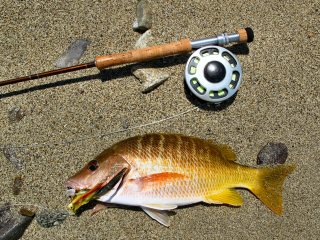June 21, 2012
Roosterfishing off the beach down here in Baja is incredible. I love the hunt. I love the difficulty. I love everything about chasing this exotic looking saltwater fish. But nothing excites me more than tossing flies over coral heads and rocks through frothing surf for big snappers and grouper – nothing! These fish will rip line from you more viciously than any other fish on the planet. Then they will bust you off so fast you can’t see straight. If you miraculously hold on long enough, then it’s likely your fish will burry and tangle you in deep water around the rocks they live in. Any time you hook one (even if it’s only a 5 pounder!); you have a very slim chance of getting him to hand. But when the stars line up and the fish Gods are on your side and you do land one, you may have one of the most spectacular looking fish of your life.
Sammy and Grant aren’t into this day like I am. They work an area hard for about and hour then seek out a short beach where they might find a rooster. Today that gave Sammy just enough time to land a flag cabrilla and this gorgeous little Panamic Grasby. If you want to get a true nice snapper you need to work all day. I never stop working it. I walk one direction all day and take the terrain nature gives me.
To fish for snapper with the fly I recommend a 10-weight. Today I was using my new Ross Rx 9’ for a 10. This rod has the needed backbone to potentially stop a good size snapper. You don’t need a reel with lots of backing capacity because if a snapper gets that far from you you’re likely to lose him anyhow, but I do like a good drag to crank down. I use Ross Momentums or their new F1 #5. It would be nice to fish down deep at the base of the rocks, but the deeper you go the more likely the chance you will get snagged and frustrated. I use the Scientific Angler saltwater floating line with the intermediate sink tip – WF10F/I. I cheat on the leader. Rather than worry about catching an IGFA record on 20lb class tippet or less, I put on a straight 4ft length of 60lb shock tippet. Straight 60lb is risky because if not handled right you could shatter a rod or snap a fly line. But it’s this strength that gives me a good chance of surviving the first couple runs into the rocks and actually landing the fish. That is if he’s not too much bigger than 10lbs. If you hook a 20lber, your 60lb tippet may as well be 7X!
My day started challenging. Even with my stout rod the wind and big waves were causing me grief. My casts were shortened not only because of the wind by also my excess line was constantly stuck in the rocks. I’m not much for the stripping basket roosterfishing off the beach but today the tool may have been perfect. I went about an hour before getting my rhythm and finally landing this beautiful flag cabrilla.
Once you catch that first fish, things generally improve. I picked up a few more cabrilla and then this gorgeous little yellow snapper. Even though this snapper is the size of a 2lb smallmouth bass, it was a good pull on the 10-weight.
For about thirty seconds I considered my rod in danger. Then it was definitely about to explode. I had to give in a little or there would be graphite flying everywhere. So I dropped my rod tip slightly and then just before my fly line was likely to break I let a very small amount of line slide out before clamping again. This tug war went on for a good two minutes when finally I started to feel my unseen fish tire. The one thing you do have going with snapper and grouper is that if you can survive the big surges for a minute or two they give up completely. That’s exactly what happened and from then on I horsed my snapper to the beach. I landed a spectacular barred pargo!
This was the second barred pargo of my life yet this one was equally as exciting as the first. These fish are striking looking with there deep round body and bright white stripes. They also have the most amazing mouth full of teeth including two big canine like teeth in their top jaws. For both pargo I’ve been by myself and had to pull off some self timer photography. Considering the surf, size of the fish and making sure I didn’t hurt him I think the photo came out ok.
Sammy and Grant searched for roosters most of the day with no luck. I admire them for their determination for an even bigger rooster. But me, I was glad I stuck to my plan and enjoyed another great day in Baja. Between Sammy and me we’ve now landed three great fish and there’s still two days left. Stay tuned. . . .






















EPIC!
Awesome Barred Pargo Jeff! I think we all need some self timer shot lessons from you…most are better than posed shots 😉
Ha – Thanks Mike! I just wanted it bad!